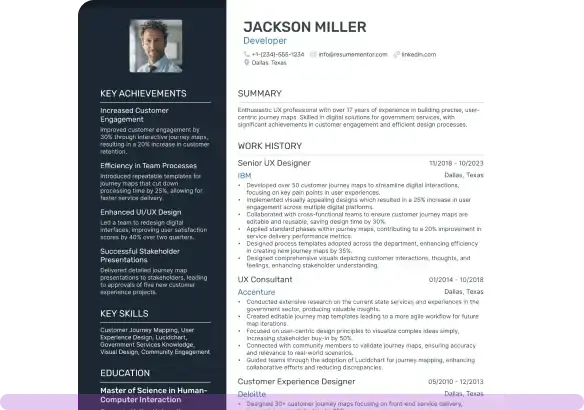Companion Caregiver Resume Examples

Mar 25, 2025
|
12 min read
Crafting a winning companion caregiver resume isn't just about listing skills; it's about telling your caregiving story. Enhance your chances of getting hired by highlighting your compassion and dedication. Let's make your caregiving credentials companionate.
Rated by 348 people
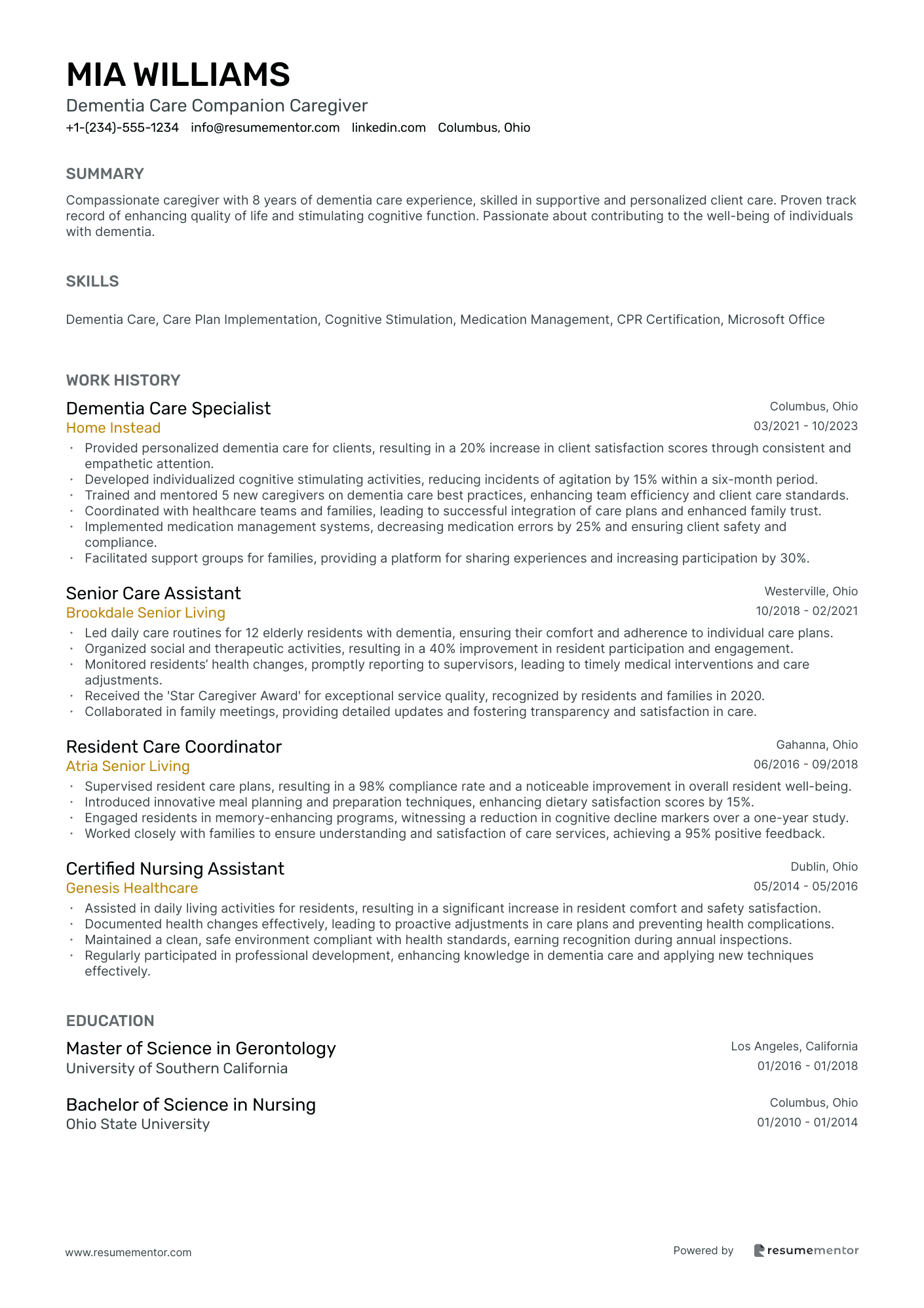
Dementia Care Companion Caregiver
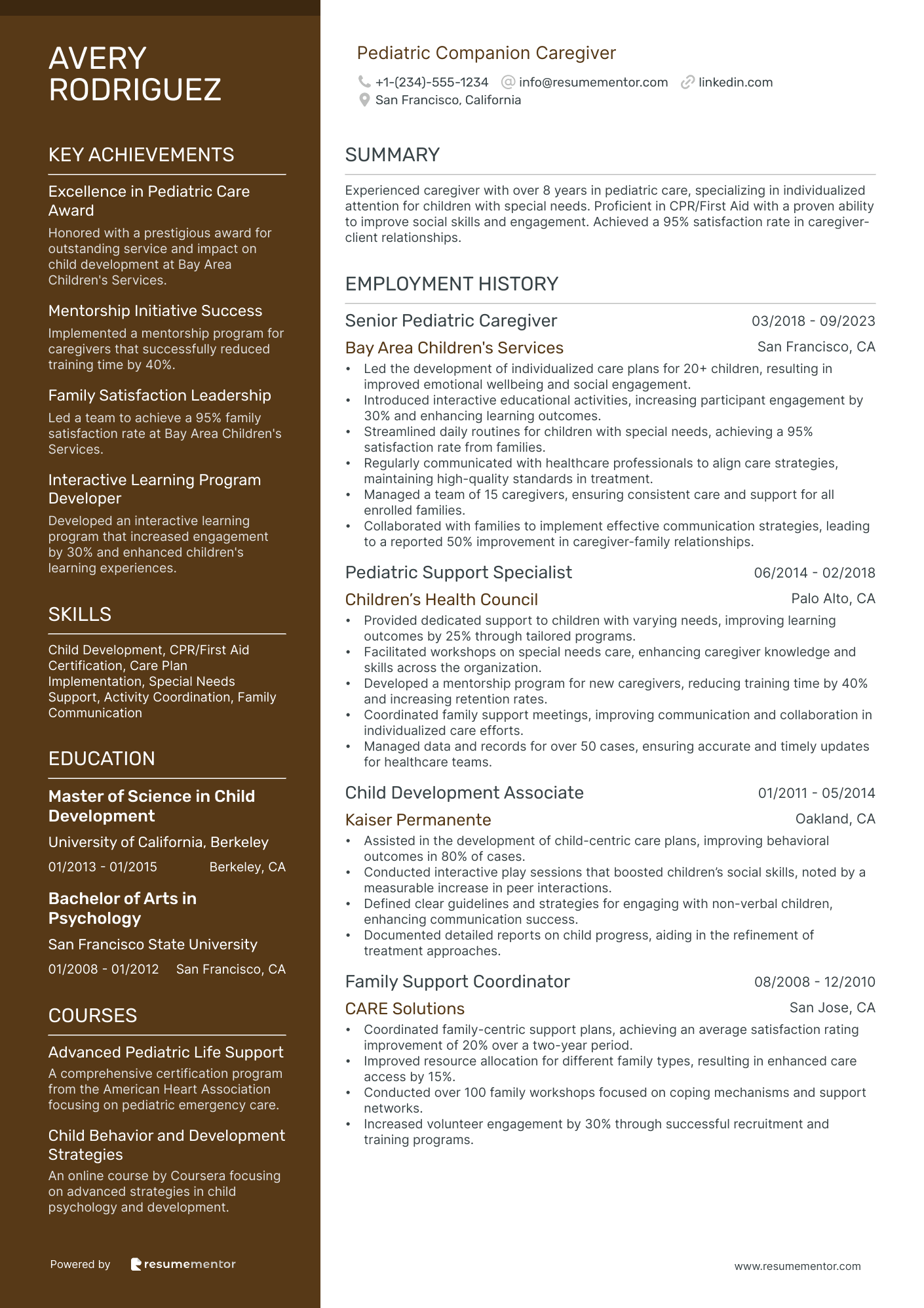
Pediatric Companion Caregiver

Elderly Companion Care Aide
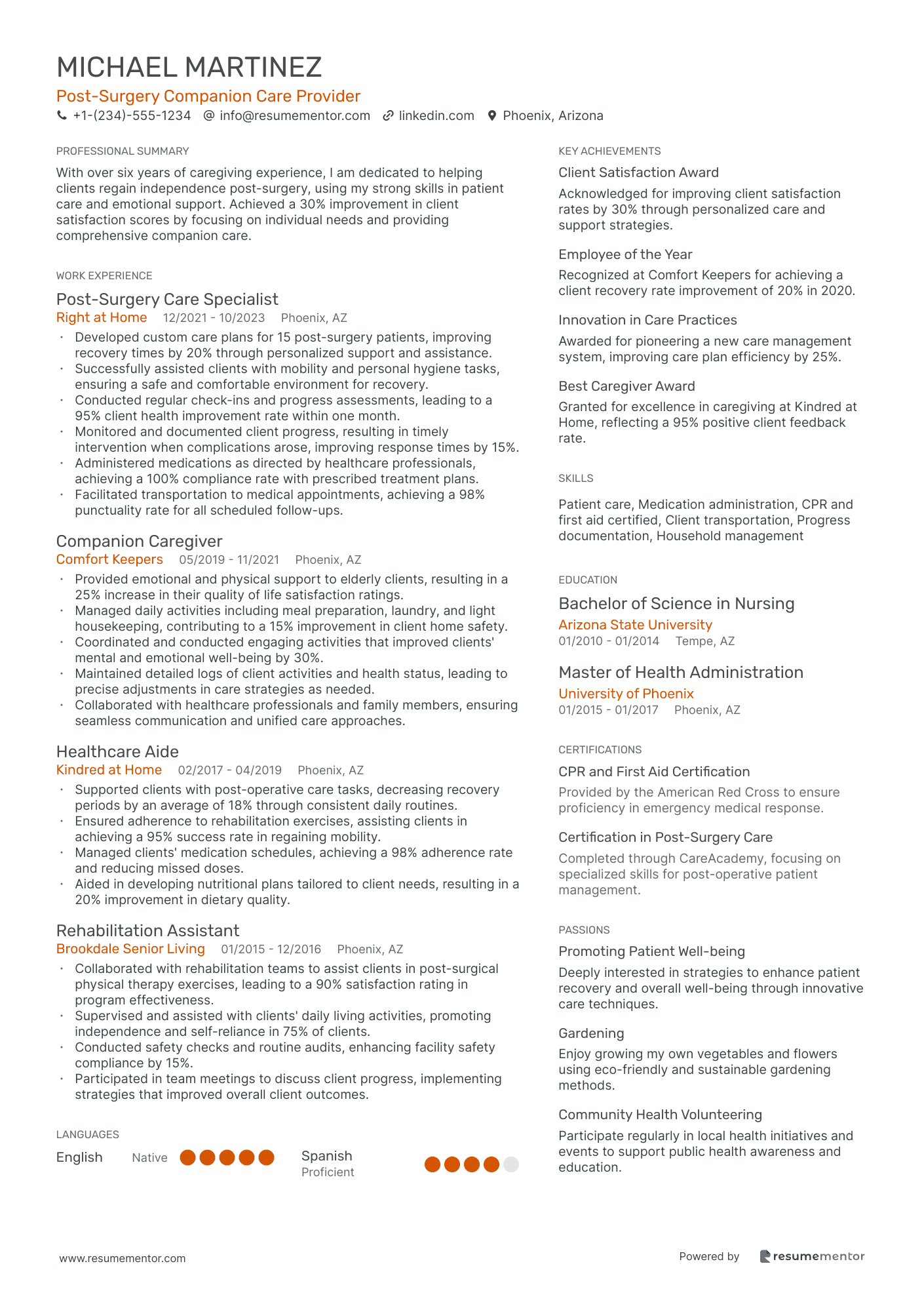
Post-Surgery Companion Care Provider
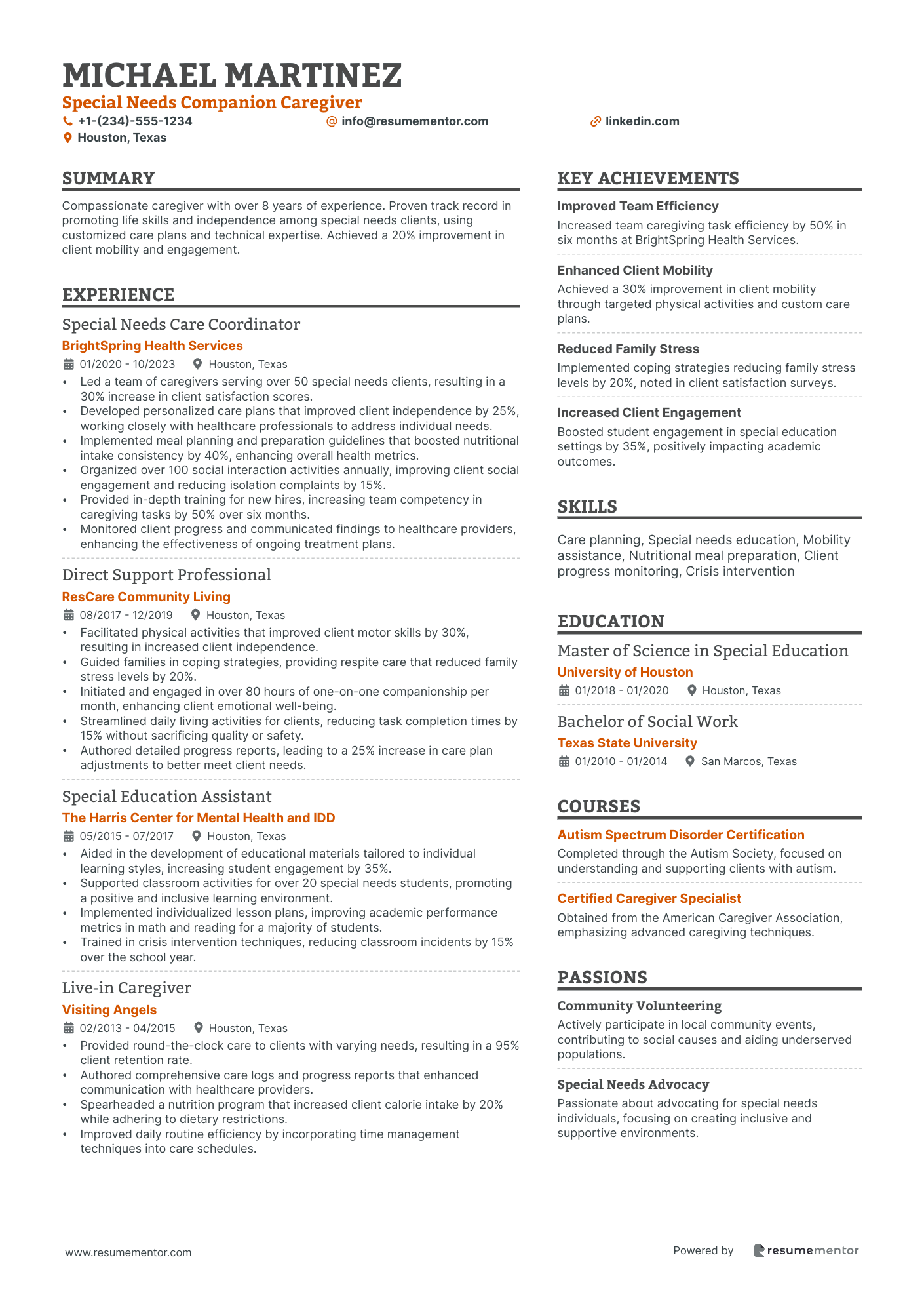
Special Needs Companion Caregiver
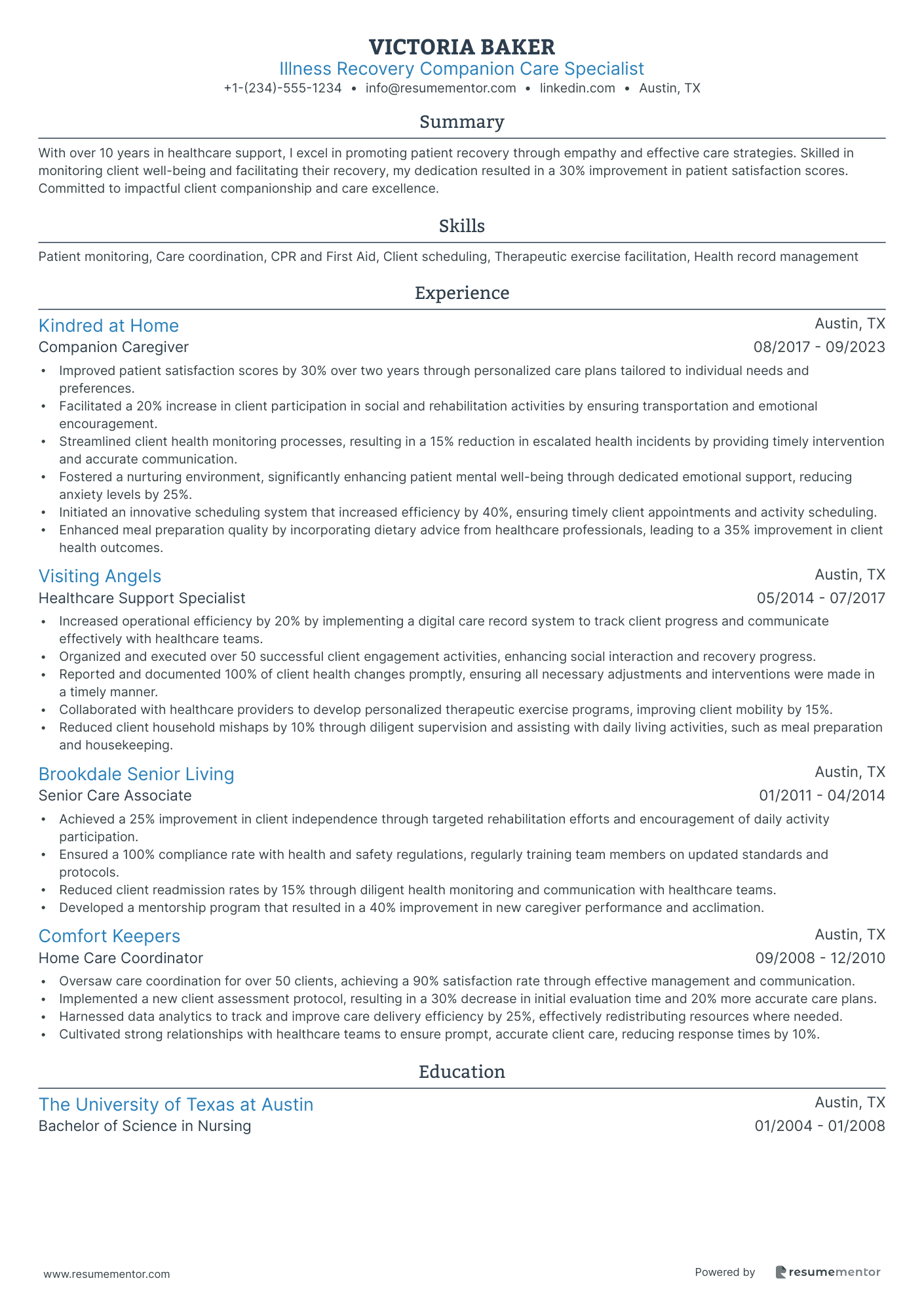
Illness Recovery Companion Care Specialist
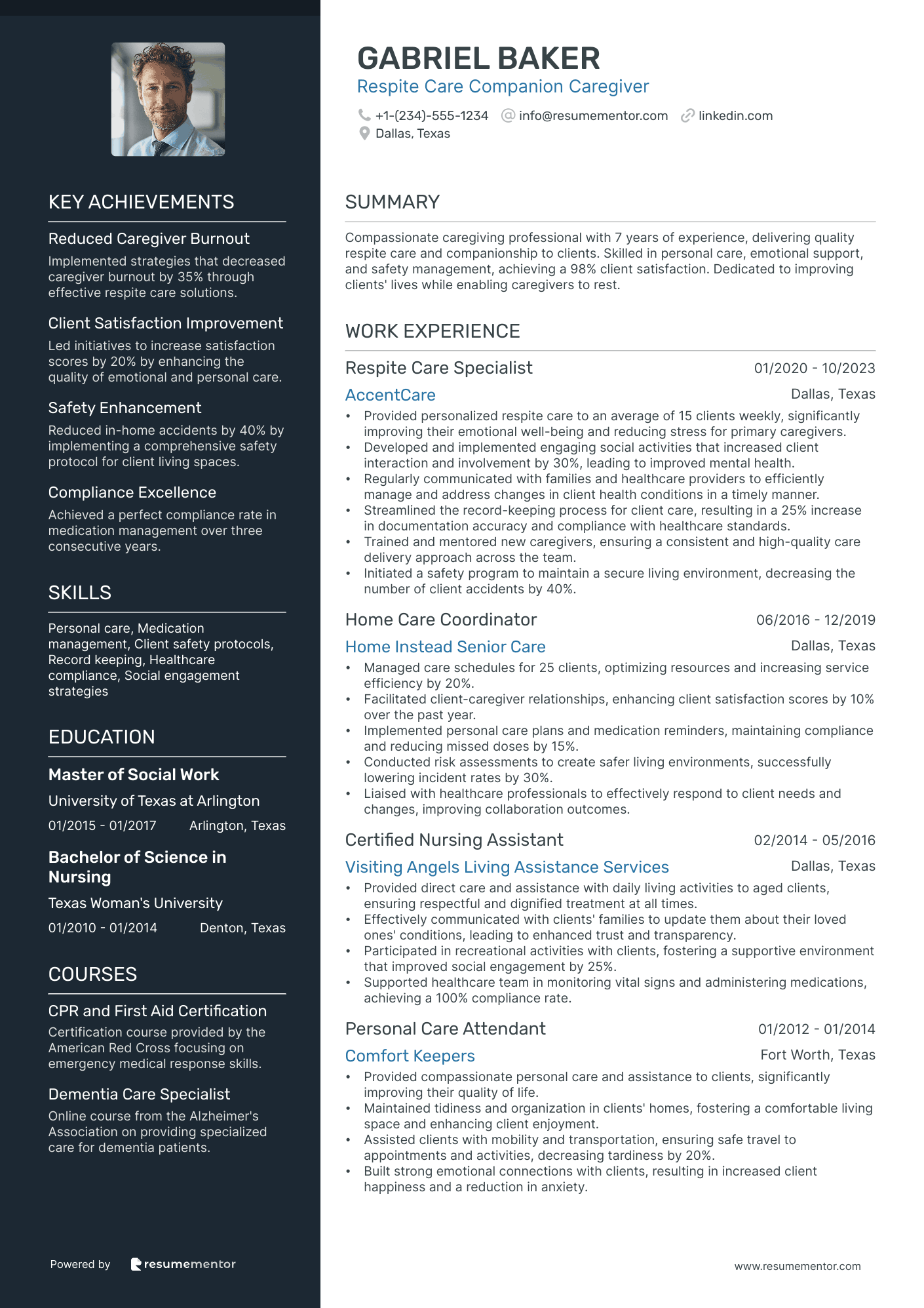
Respite Care Companion Caregiver
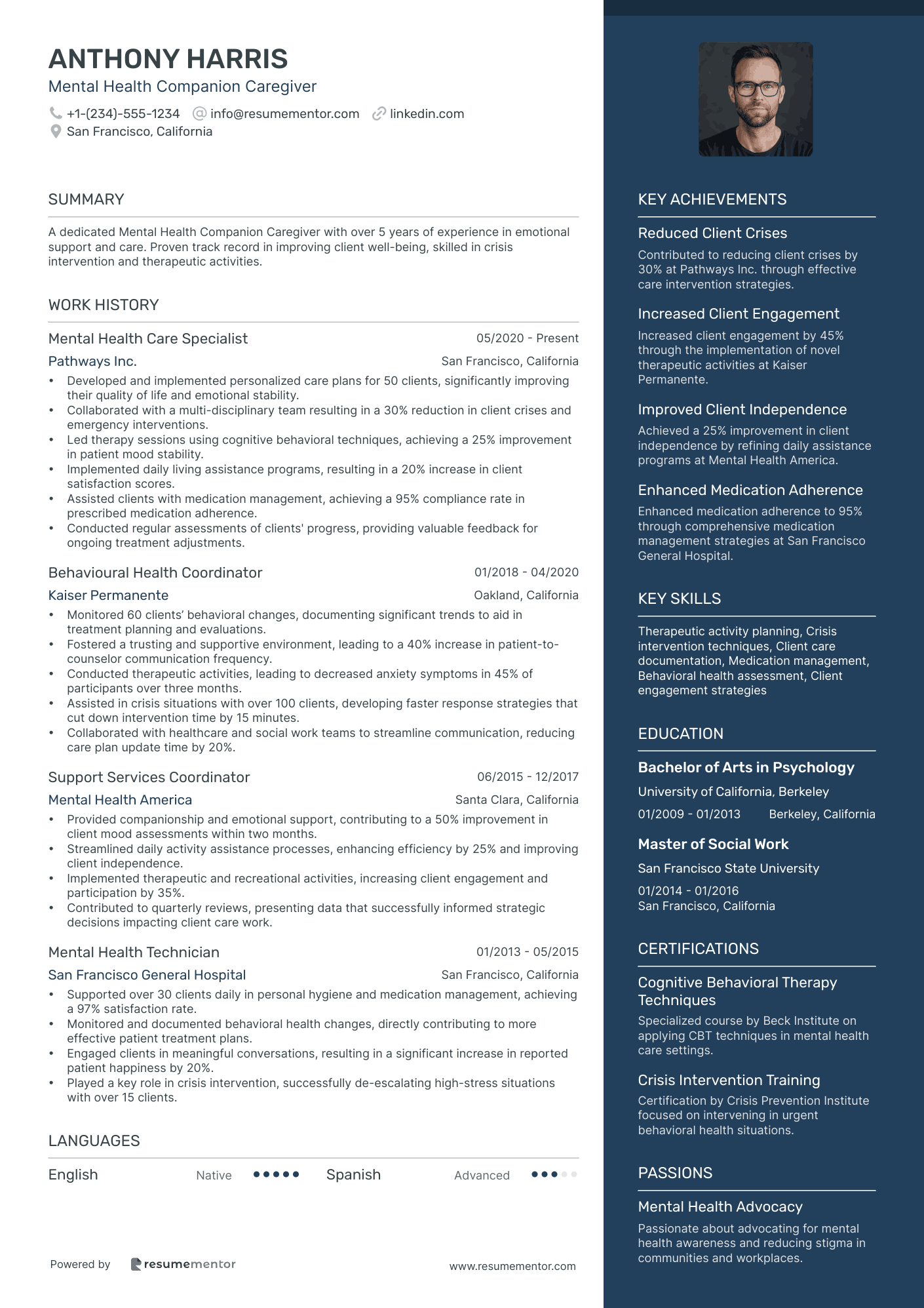
Mental Health Companion Caregiver
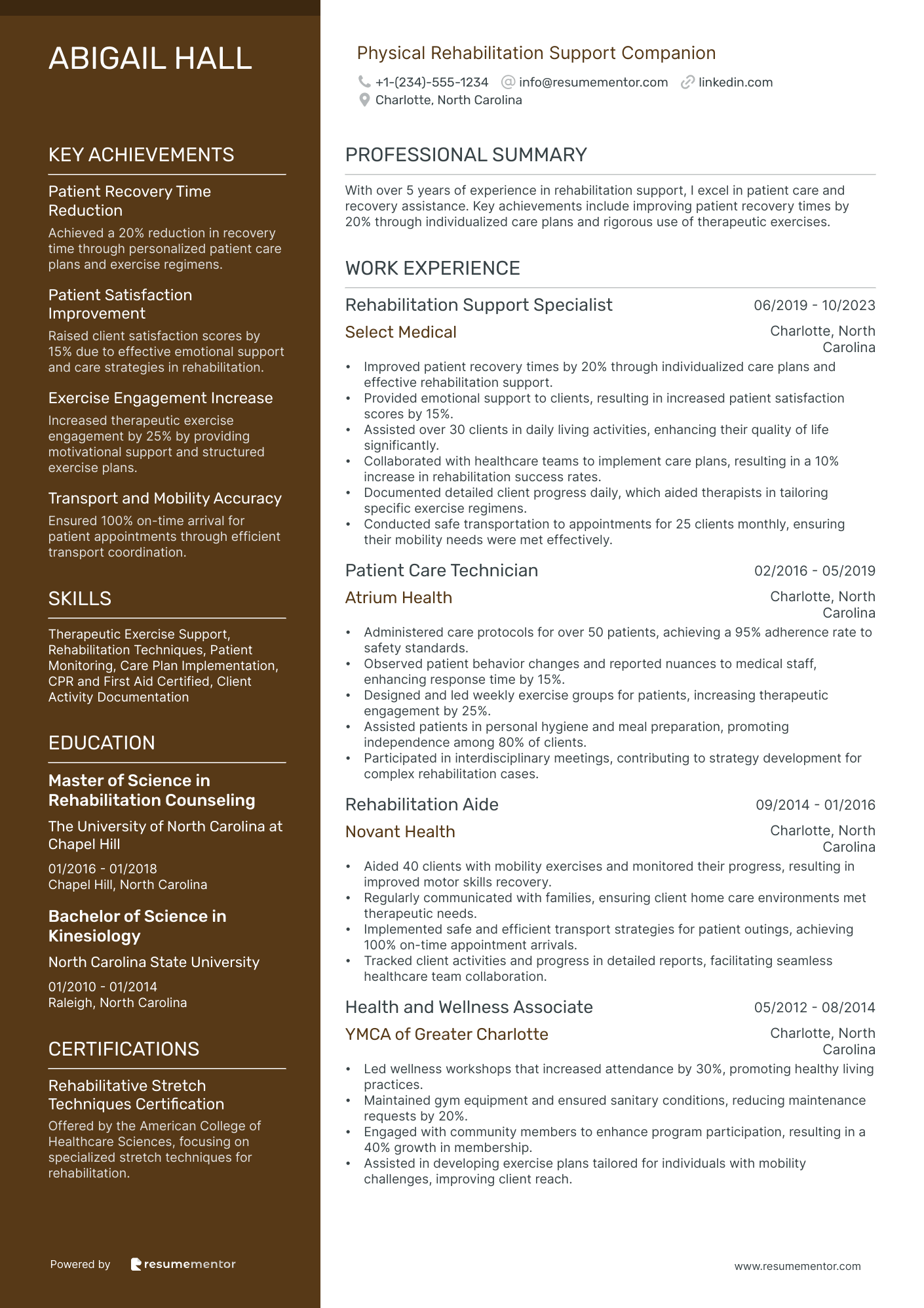
Physical Rehabilitation Support Companion
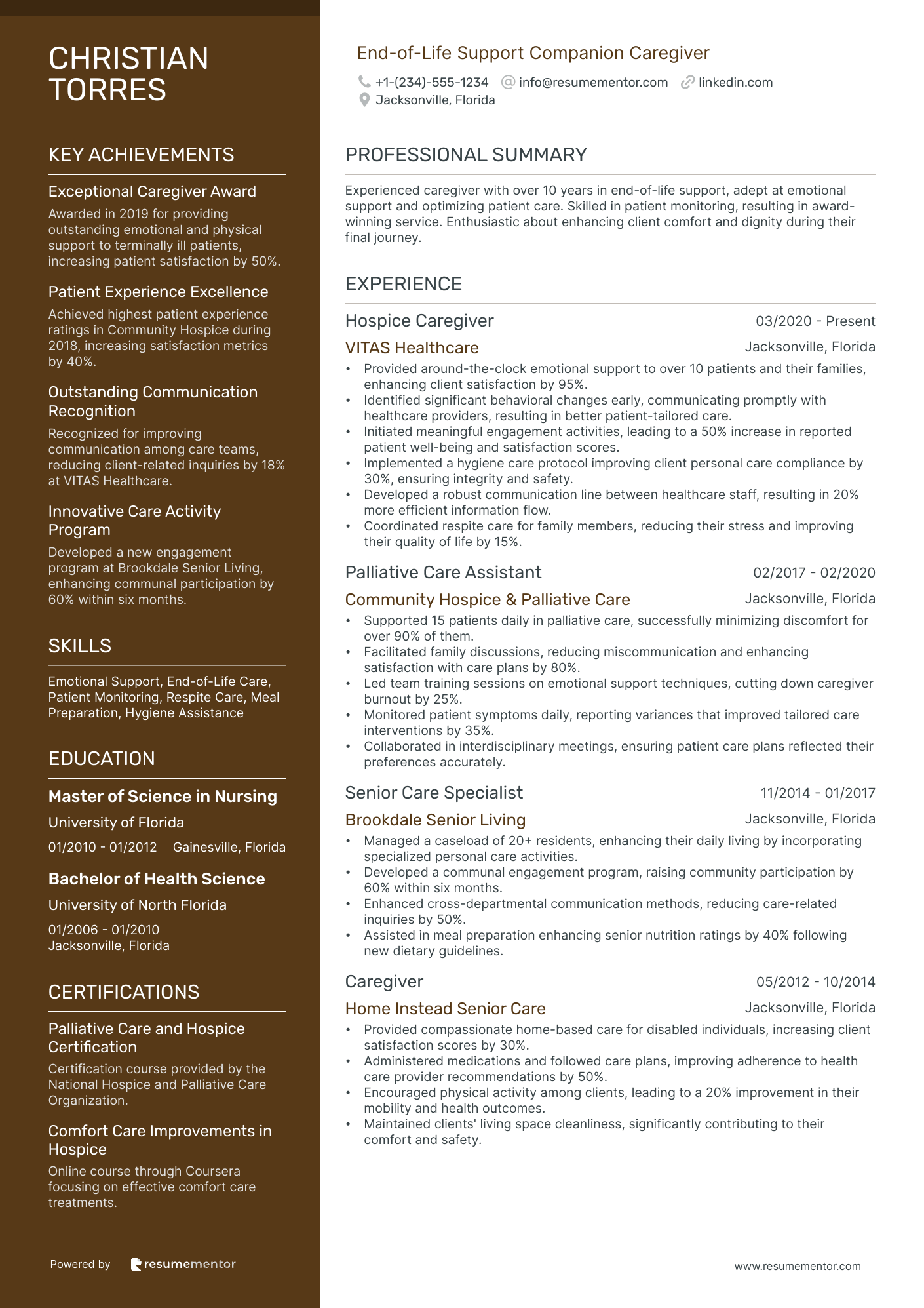
End-of-Life Support Companion Caregiver

Dementia Care Companion Caregiver resume sample
- •Provided personalized dementia care for clients, resulting in a 20% increase in client satisfaction scores through consistent and empathetic attention.
- •Developed individualized cognitive stimulating activities, reducing incidents of agitation by 15% within a six-month period.
- •Trained and mentored 5 new caregivers on dementia care best practices, enhancing team efficiency and client care standards.
- •Coordinated with healthcare teams and families, leading to successful integration of care plans and enhanced family trust.
- •Implemented medication management systems, decreasing medication errors by 25% and ensuring client safety and compliance.
- •Facilitated support groups for families, providing a platform for sharing experiences and increasing participation by 30%.
- •Led daily care routines for 12 elderly residents with dementia, ensuring their comfort and adherence to individual care plans.
- •Organized social and therapeutic activities, resulting in a 40% improvement in resident participation and engagement.
- •Monitored residents’ health changes, promptly reporting to supervisors, leading to timely medical interventions and care adjustments.
- •Received the 'Star Caregiver Award' for exceptional service quality, recognized by residents and families in 2020.
- •Collaborated in family meetings, providing detailed updates and fostering transparency and satisfaction in care.
- •Supervised resident care plans, resulting in a 98% compliance rate and a noticeable improvement in overall resident well-being.
- •Introduced innovative meal planning and preparation techniques, enhancing dietary satisfaction scores by 15%.
- •Engaged residents in memory-enhancing programs, witnessing a reduction in cognitive decline markers over a one-year study.
- •Worked closely with families to ensure understanding and satisfaction of care services, achieving a 95% positive feedback.
- •Assisted in daily living activities for residents, resulting in a significant increase in resident comfort and safety satisfaction.
- •Documented health changes effectively, leading to proactive adjustments in care plans and preventing health complications.
- •Maintained a clean, safe environment compliant with health standards, earning recognition during annual inspections.
- •Regularly participated in professional development, enhancing knowledge in dementia care and applying new techniques effectively.
Pediatric Companion Caregiver resume sample
- •Led the development of individualized care plans for 20+ children, resulting in improved emotional wellbeing and social engagement.
- •Introduced interactive educational activities, increasing participant engagement by 30% and enhancing learning outcomes.
- •Streamlined daily routines for children with special needs, achieving a 95% satisfaction rate from families.
- •Regularly communicated with healthcare professionals to align care strategies, maintaining high-quality standards in treatment.
- •Managed a team of 15 caregivers, ensuring consistent care and support for all enrolled families.
- •Collaborated with families to implement effective communication strategies, leading to a reported 50% improvement in caregiver-family relationships.
- •Provided dedicated support to children with varying needs, improving learning outcomes by 25% through tailored programs.
- •Facilitated workshops on special needs care, enhancing caregiver knowledge and skills across the organization.
- •Developed a mentorship program for new caregivers, reducing training time by 40% and increasing retention rates.
- •Coordinated family support meetings, improving communication and collaboration in individualized care efforts.
- •Managed data and records for over 50 cases, ensuring accurate and timely updates for healthcare teams.
- •Assisted in the development of child-centric care plans, improving behavioral outcomes in 80% of cases.
- •Conducted interactive play sessions that boosted children’s social skills, noted by a measurable increase in peer interactions.
- •Defined clear guidelines and strategies for engaging with non-verbal children, enhancing communication success.
- •Documented detailed reports on child progress, aiding in the refinement of treatment approaches.
- •Coordinated family-centric support plans, achieving an average satisfaction rating improvement of 20% over a two-year period.
- •Improved resource allocation for different family types, resulting in enhanced care access by 15%.
- •Conducted over 100 family workshops focused on coping mechanisms and support networks.
- •Increased volunteer engagement by 30% through successful recruitment and training programs.
Elderly Companion Care Aide resume sample
- •Successfully improved client satisfaction rates by 30% through personalized care plans and regular client check-ins.
- •Managed a team of 5 aides, leading to a 20% increase in operational efficiency through streamlined communication processes.
- •Initiated and developed engaging social activities for seniors, increasing client participation by over 40%.
- •Monitored clients' health conditions, reporting critical changes promptly to family members and healthcare providers.
- •Implemented enhanced safety protocols that decreased in-home accidents by 15%, ensuring safer living spaces.
- •Optimized medication delivery system, resulting in 25% improved compliance among clients.
- •Facilitated daily living activities for 10 clients, yielding a 40% improvement in their day-to-day satisfaction.
- •Reduced client isolation by 35% by organizing community outings, group discussions, and interactive sessions.
- •Enhanced client relationships by initiating bi-weekly feedback sessions, contributing to personalized care adjustments.
- •Trained junior staff on care standards, noticeably improving team consistency and client experience by 20%.
- •Implemented a successful nutrition plan that improved client nutrition by 25%, leading to increased energy levels.
- •Provided personal care for 8 elderly clients, enhancing their grooming routines and elevating personal hygiene by 50%.
- •Established strong relationships with clients and families, gaining 95% positive feedback ratings.
- •Reduced emergency incidents by 20% through diligent monitoring and preventive measures.
- •Assisted seniors with mobility challenges, resulting in improved independence and a 15% reduction in fall incidents.
- •Supported day-to-day activities, including light housekeeping and meal prep, improving clients' quality of life by 25%.
- •Built a robust client-caregiver relationship, increasing trust and comfort levels among clients significantly.
- •Achieved 98% accuracy in medication delivery, contributing to improved health outcomes for clients.
- •Promoted social interaction through regular client-enriched activities and community engagement.
Post-Surgery Companion Care Provider resume sample
- •Developed custom care plans for 15 post-surgery patients, improving recovery times by 20% through personalized support and assistance.
- •Successfully assisted clients with mobility and personal hygiene tasks, ensuring a safe and comfortable environment for recovery.
- •Conducted regular check-ins and progress assessments, leading to a 95% client health improvement rate within one month.
- •Monitored and documented client progress, resulting in timely intervention when complications arose, improving response times by 15%.
- •Administered medications as directed by healthcare professionals, achieving a 100% compliance rate with prescribed treatment plans.
- •Facilitated transportation to medical appointments, achieving a 98% punctuality rate for all scheduled follow-ups.
- •Provided emotional and physical support to elderly clients, resulting in a 25% increase in their quality of life satisfaction ratings.
- •Managed daily activities including meal preparation, laundry, and light housekeeping, contributing to a 15% improvement in client home safety.
- •Coordinated and conducted engaging activities that improved clients' mental and emotional well-being by 30%.
- •Maintained detailed logs of client activities and health status, leading to precise adjustments in care strategies as needed.
- •Collaborated with healthcare professionals and family members, ensuring seamless communication and unified care approaches.
- •Supported clients with post-operative care tasks, decreasing recovery periods by an average of 18% through consistent daily routines.
- •Ensured adherence to rehabilitation exercises, assisting clients in achieving a 95% success rate in regaining mobility.
- •Managed clients' medication schedules, achieving a 98% adherence rate and reducing missed doses.
- •Aided in developing nutritional plans tailored to client needs, resulting in a 20% improvement in dietary quality.
- •Collaborated with rehabilitation teams to assist clients in post-surgical physical therapy exercises, leading to a 90% satisfaction rating in program effectiveness.
- •Supervised and assisted with clients' daily living activities, promoting independence and self-reliance in 75% of clients.
- •Conducted safety checks and routine audits, enhancing facility safety compliance by 15%.
- •Participated in team meetings to discuss client progress, implementing strategies that improved overall client outcomes.
Special Needs Companion Caregiver resume sample
- •Led a team of caregivers serving over 50 special needs clients, resulting in a 30% increase in client satisfaction scores.
- •Developed personalized care plans that improved client independence by 25%, working closely with healthcare professionals to address individual needs.
- •Implemented meal planning and preparation guidelines that boosted nutritional intake consistency by 40%, enhancing overall health metrics.
- •Organized over 100 social interaction activities annually, improving client social engagement and reducing isolation complaints by 15%.
- •Provided in-depth training for new hires, increasing team competency in caregiving tasks by 50% over six months.
- •Monitored client progress and communicated findings to healthcare providers, enhancing the effectiveness of ongoing treatment plans.
- •Facilitated physical activities that improved client motor skills by 30%, resulting in increased client independence.
- •Guided families in coping strategies, providing respite care that reduced family stress levels by 20%.
- •Initiated and engaged in over 80 hours of one-on-one companionship per month, enhancing client emotional well-being.
- •Streamlined daily living activities for clients, reducing task completion times by 15% without sacrificing quality or safety.
- •Authored detailed progress reports, leading to a 25% increase in care plan adjustments to better meet client needs.
- •Aided in the development of educational materials tailored to individual learning styles, increasing student engagement by 35%.
- •Supported classroom activities for over 20 special needs students, promoting a positive and inclusive learning environment.
- •Implemented individualized lesson plans, improving academic performance metrics in math and reading for a majority of students.
- •Trained in crisis intervention techniques, reducing classroom incidents by 15% over the school year.
- •Provided round-the-clock care to clients with varying needs, resulting in a 95% client retention rate.
- •Authored comprehensive care logs and progress reports that enhanced communication with healthcare providers.
- •Spearheaded a nutrition program that increased client calorie intake by 20% while adhering to dietary restrictions.
- •Improved daily routine efficiency by incorporating time management techniques into care schedules.
Illness Recovery Companion Care Specialist resume sample
- •Improved patient satisfaction scores by 30% over two years through personalized care plans tailored to individual needs and preferences.
- •Facilitated a 20% increase in client participation in social and rehabilitation activities by ensuring transportation and emotional encouragement.
- •Streamlined client health monitoring processes, resulting in a 15% reduction in escalated health incidents by providing timely intervention and accurate communication.
- •Fostered a nurturing environment, significantly enhancing patient mental well-being through dedicated emotional support, reducing anxiety levels by 25%.
- •Initiated an innovative scheduling system that increased efficiency by 40%, ensuring timely client appointments and activity scheduling.
- •Enhanced meal preparation quality by incorporating dietary advice from healthcare professionals, leading to a 35% improvement in client health outcomes.
- •Increased operational efficiency by 20% by implementing a digital care record system to track client progress and communicate effectively with healthcare teams.
- •Organized and executed over 50 successful client engagement activities, enhancing social interaction and recovery progress.
- •Reported and documented 100% of client health changes promptly, ensuring all necessary adjustments and interventions were made in a timely manner.
- •Collaborated with healthcare providers to develop personalized therapeutic exercise programs, improving client mobility by 15%.
- •Reduced client household mishaps by 10% through diligent supervision and assisting with daily living activities, such as meal preparation and housekeeping.
- •Achieved a 25% improvement in client independence through targeted rehabilitation efforts and encouragement of daily activity participation.
- •Ensured a 100% compliance rate with health and safety regulations, regularly training team members on updated standards and protocols.
- •Reduced client readmission rates by 15% through diligent health monitoring and communication with healthcare teams.
- •Developed a mentorship program that resulted in a 40% improvement in new caregiver performance and acclimation.
- •Oversaw care coordination for over 50 clients, achieving a 90% satisfaction rate through effective management and communication.
- •Implemented a new client assessment protocol, resulting in a 30% decrease in initial evaluation time and 20% more accurate care plans.
- •Harnessed data analytics to track and improve care delivery efficiency by 25%, effectively redistributing resources where needed.
- •Cultivated strong relationships with healthcare teams to ensure prompt, accurate client care, reducing response times by 10%.
Respite Care Companion Caregiver resume sample
- •Provided personalized respite care to an average of 15 clients weekly, significantly improving their emotional well-being and reducing stress for primary caregivers.
- •Developed and implemented engaging social activities that increased client interaction and involvement by 30%, leading to improved mental health.
- •Regularly communicated with families and healthcare providers to efficiently manage and address changes in client health conditions in a timely manner.
- •Streamlined the record-keeping process for client care, resulting in a 25% increase in documentation accuracy and compliance with healthcare standards.
- •Trained and mentored new caregivers, ensuring a consistent and high-quality care delivery approach across the team.
- •Initiated a safety program to maintain a secure living environment, decreasing the number of client accidents by 40%.
- •Managed care schedules for 25 clients, optimizing resources and increasing service efficiency by 20%.
- •Facilitated client-caregiver relationships, enhancing client satisfaction scores by 10% over the past year.
- •Implemented personal care plans and medication reminders, maintaining compliance and reducing missed doses by 15%.
- •Conducted risk assessments to create safer living environments, successfully lowering incident rates by 30%.
- •Liaised with healthcare professionals to effectively respond to client needs and changes, improving collaboration outcomes.
- •Provided direct care and assistance with daily living activities to aged clients, ensuring respectful and dignified treatment at all times.
- •Effectively communicated with clients' families to update them about their loved ones' conditions, leading to enhanced trust and transparency.
- •Participated in recreational activities with clients, fostering a supportive environment that improved social engagement by 25%.
- •Supported healthcare team in monitoring vital signs and administering medications, achieving a 100% compliance rate.
- •Provided compassionate personal care and assistance to clients, significantly improving their quality of life.
- •Maintained tidiness and organization in clients' homes, fostering a comfortable living space and enhancing client enjoyment.
- •Assisted clients with mobility and transportation, ensuring safe travel to appointments and activities, decreasing tardiness by 20%.
- •Built strong emotional connections with clients, resulting in increased client happiness and a reduction in anxiety.
Mental Health Companion Caregiver resume sample
- •Developed and implemented personalized care plans for 50 clients, significantly improving their quality of life and emotional stability.
- •Collaborated with a multi-disciplinary team resulting in a 30% reduction in client crises and emergency interventions.
- •Led therapy sessions using cognitive behavioral techniques, achieving a 25% improvement in patient mood stability.
- •Implemented daily living assistance programs, resulting in a 20% increase in client satisfaction scores.
- •Assisted clients with medication management, achieving a 95% compliance rate in prescribed medication adherence.
- •Conducted regular assessments of clients' progress, providing valuable feedback for ongoing treatment adjustments.
- •Monitored 60 clients’ behavioral changes, documenting significant trends to aid in treatment planning and evaluations.
- •Fostered a trusting and supportive environment, leading to a 40% increase in patient-to-counselor communication frequency.
- •Conducted therapeutic activities, leading to decreased anxiety symptoms in 45% of participants over three months.
- •Assisted in crisis situations with over 100 clients, developing faster response strategies that cut down intervention time by 15 minutes.
- •Collaborated with healthcare and social work teams to streamline communication, reducing care plan update time by 20%.
- •Provided companionship and emotional support, contributing to a 50% improvement in client mood assessments within two months.
- •Streamlined daily activity assistance processes, enhancing efficiency by 25% and improving client independence.
- •Implemented therapeutic and recreational activities, increasing client engagement and participation by 35%.
- •Contributed to quarterly reviews, presenting data that successfully informed strategic decisions impacting client care work.
- •Supported over 30 clients daily in personal hygiene and medication management, achieving a 97% satisfaction rate.
- •Monitored and documented behavioral health changes, directly contributing to more effective patient treatment plans.
- •Engaged clients in meaningful conversations, resulting in a significant increase in reported patient happiness by 20%.
- •Played a key role in crisis intervention, successfully de-escalating high-stress situations with over 15 clients.
Physical Rehabilitation Support Companion resume sample
- •Improved patient recovery times by 20% through individualized care plans and effective rehabilitation support.
- •Provided emotional support to clients, resulting in increased patient satisfaction scores by 15%.
- •Assisted over 30 clients in daily living activities, enhancing their quality of life significantly.
- •Collaborated with healthcare teams to implement care plans, resulting in a 10% increase in rehabilitation success rates.
- •Documented detailed client progress daily, which aided therapists in tailoring specific exercise regimens.
- •Conducted safe transportation to appointments for 25 clients monthly, ensuring their mobility needs were met effectively.
- •Administered care protocols for over 50 patients, achieving a 95% adherence rate to safety standards.
- •Observed patient behavior changes and reported nuances to medical staff, enhancing response time by 15%.
- •Designed and led weekly exercise groups for patients, increasing therapeutic engagement by 25%.
- •Assisted patients in personal hygiene and meal preparation, promoting independence among 80% of clients.
- •Participated in interdisciplinary meetings, contributing to strategy development for complex rehabilitation cases.
- •Aided 40 clients with mobility exercises and monitored their progress, resulting in improved motor skills recovery.
- •Regularly communicated with families, ensuring client home care environments met therapeutic needs.
- •Implemented safe and efficient transport strategies for patient outings, achieving 100% on-time appointment arrivals.
- •Tracked client activities and progress in detailed reports, facilitating seamless healthcare team collaboration.
- •Led wellness workshops that increased attendance by 30%, promoting healthy living practices.
- •Maintained gym equipment and ensured sanitary conditions, reducing maintenance requests by 20%.
- •Engaged with community members to enhance program participation, resulting in a 40% growth in membership.
- •Assisted in developing exercise plans tailored for individuals with mobility challenges, improving client reach.
End-of-Life Support Companion Caregiver resume sample
- •Provided around-the-clock emotional support to over 10 patients and their families, enhancing client satisfaction by 95%.
- •Identified significant behavioral changes early, communicating promptly with healthcare providers, resulting in better patient-tailored care.
- •Initiated meaningful engagement activities, leading to a 50% increase in reported patient well-being and satisfaction scores.
- •Implemented a hygiene care protocol improving client personal care compliance by 30%, ensuring integrity and safety.
- •Developed a robust communication line between healthcare staff, resulting in 20% more efficient information flow.
- •Coordinated respite care for family members, reducing their stress and improving their quality of life by 15%.
- •Supported 15 patients daily in palliative care, successfully minimizing discomfort for over 90% of them.
- •Facilitated family discussions, reducing miscommunication and enhancing satisfaction with care plans by 80%.
- •Led team training sessions on emotional support techniques, cutting down caregiver burnout by 25%.
- •Monitored patient symptoms daily, reporting variances that improved tailored care interventions by 35%.
- •Collaborated in interdisciplinary meetings, ensuring patient care plans reflected their preferences accurately.
- •Managed a caseload of 20+ residents, enhancing their daily living by incorporating specialized personal care activities.
- •Developed a communal engagement program, raising community participation by 60% within six months.
- •Enhanced cross-departmental communication methods, reducing care-related inquiries by 50%.
- •Assisted in meal preparation enhancing senior nutrition ratings by 40% following new dietary guidelines.
- •Provided compassionate home-based care for disabled individuals, increasing client satisfaction scores by 30%.
- •Administered medications and followed care plans, improving adherence to health care provider recommendations by 50%.
- •Encouraged physical activity among clients, leading to a 20% improvement in their mobility and health outcomes.
- •Maintained clients' living space cleanliness, significantly contributing to their comfort and safety.
As a companion caregiver, crafting a resume that captures your diverse skills is crucial because it connects your valuable experience with potential employers. This resume acts as a bridge, translating the art of companionship into a format they can appreciate. Yet, expressing the depth of your caregiving abilities on paper can be challenging, as it requires careful thought.
Balancing both your emotional and practical caregiving skills on your resume is key. It’s important to highlight the empathy you bring, alongside the tasks that ensure your clients’ comfort and dignity, showcasing how comprehensive your expertise truly is. This goes beyond basic caregiving, demonstrating your deep understanding of your clients' needs.
To organize these elements effectively, consider using a resume template. This tool can structure your information professionally, helping you make a strong first impression. You can explore options at resume templates to find the best fit for your unique style.
Approaching the resume-building process with the right tools can make it feel less daunting. Remember, you're more than just a list of tasks; your resume should reflect the heart and soul you bring to your role. It's an opportunity to share your unique story and the meaningful work you do, engaging potential employers in the essence of your caregiving journey.
Key Takeaways
- To effectively convey your caregiving skills on a resume, balance emotional and practical abilities while showing empathy and ensuring clients' comfort and dignity.
- Using a professional resume template can help organize your information, making a strong first impression on potential employers.
- Opt for a resume format that matches your career history, such as chronological for steady employment or functional for career shifts, to highlight relevant strengths.
- Include specific examples and quantifiable achievements in the experience section to showcase your hands-on experience and impact on clients.
- Highlight both hard skills like CPR and medication management, and soft skills such as empathy and communication, to demonstrate your qualifications and fit for the caregiver role.
What to focus on when writing your companion caregiver resume
As a companion caregiver, your resume should clearly highlight your ability to provide empathetic and reliable care. Emphasize your experience with daily activities, companionship, and maintaining a safe environment for clients—these elements demonstrate your commitment to their well-being.
How to structure your companion caregiver resume
- **Contact Information**—Include your full name, phone number, and professional email. Adding your city and state can establish local relevance, making it easier for potential employers to see your availability for nearby opportunities.
- **Professional Summary**—Crafting a strong summary involves providing a snapshot of your caregiving experience and passion for supporting others. Use phrases like "compassionate caregiver" or "experienced with dementia care" to highlight your strengths—this section sets the tone for your qualifications and lets employers know what makes you a standout candidate immediately.
- **Experience**—When detailing your experience, focusing on relevant roles and achievements is crucial. Include specific tasks like aiding mobility, preparing meals, or offering emotional support. These examples help build a clear picture of your capabilities and show a proven track record that potential employers are eager to see.
- **Skills**—Listing your skills involves featuring qualities such as communication, patience, first aid, and medication management. Tailor these skills specifically to the caregiver role to clearly demonstrate how you fit the job requirements and meet the needs of those you care for.
- **Education and Certifications**—Including your education and certifications is also key. Mention any degrees or certifications like CPR or CNA, which enhance your qualifications and lend additional credibility to your expertise as a caregiver.
- **References**—Adding references provides potential employers with reliable endorsements. Listing contacts from past employers or supervisors who can vouch for your caregiving skills gives an additional layer of trust and authenticity.
Thinking about optional sections like Volunteer Work or Languages Spoken can enrich your application further. These touches add depth and showcase a well-rounded profile committed to caregiving. Below, we will cover each resume section more in-depth to help you best represent your strengths.
Which resume format to choose
Creating a resume as a companion caregiver involves thoughtful choices to best highlight your specific strengths and experience. Start by selecting the right format that matches your career history. A chronological format works well if you've had steady employment, as it clearly illustrates your progression and reliability. However, if you have gaps in your work history or are shifting from another field, a functional format might be more effective. This setup focuses on showcasing the diverse skills you can bring to caregiving, which is valuable when providing personalized, empathetic care.
When choosing fonts, consider options like Lato, Montserrat, or Raleway. These fonts offer a modern look that can subtly enhance the professionalism of your resume. A consistent, clean font choice supports the presentation of your experiences and skills, making it easier for employers to engage with your content.
Saving your resume as a PDF is an important step to protect the integrity of your formatting. PDFs ensure your resume appears correctly on any device, which is critical for making a strong, professional impression. Consistency in presentation can reinforce your reliability and attention to detail, traits that are essential in a caregiving role.
Proper margins are also significant in creating a balanced and easy-to-read resume. Setting them to around 1 inch on all sides ensures there’s ample white space, making your content accessible and inviting. This attention to layout reflects your ability to organize information thoughtfully, a skill that translates well to the methodical aspects of caregiving.
By integrating these elements thoughtfully, your resume will present you as a polished and competent candidate for a companion caregiver position.
How to write a quantifiable resume experience section
The experience section in your resume as a companion caregiver is essential for highlighting your skills and achievements. Focus on detailing your hands-on experience and the impact you've had on individuals you’ve cared for, using a structure that lists your most recent position first. Keeping it relevant, consider going back about ten to fifteen years. Choose job titles that align with your target roles and carefully tailor each entry to the job ad. Strong action words like “assisted,” “coordinated,” “enhanced,” and “supported” effectively showcase your contributions. By mirroring the job description's language and addressing key responsibilities, you'll create an entry that connects closely to what employers seek.
Here's an engaging example of a companion caregiver experience section:
- •Assisted clients with daily living activities, leading to a 95% satisfaction rate in client feedback surveys.
- •Implemented personalized care plans that improved clients' physical health metrics by 20% over six months.
- •Coordinated with medical professionals, resulting in a 30% reduction in hospital visits for recurring issues.
- •Enhanced mental well-being by organizing activities, boosting client engagement by 50% in weekly reports.
This example stands out because it seamlessly interlinks your tangible results with the positive changes in your clients' lives. The opening lines set a strong foundation by clearly identifying the role and company. Each bullet point not only uses strong verbs but ties directly to measurable outcomes, highlighting your impact and commitment. This tailored approach ensures that your experience resonates with potential employers by aligning with the desired skills and responsibilities in job ads. The overall flow connects each aspect naturally, painting a vivid picture of your accomplishments in caregiving.
Growth-Focused resume experience section
A growth-focused companion caregiver resume experience section should highlight your ability to enhance patient care while promoting personal and professional growth. Begin by identifying a key area where you’ve made a difference and connect it to clear, positive outcomes. Be specific about your achievements and demonstrate the positive impact they’ve had on those you’ve cared for, aligning each bullet point with the skills and accomplishments most relevant to the job you’re pursuing. Whether it’s improving patient wellbeing, offering creative care solutions, or anticipating needs, make your contributions stand out.
Keep the flow engaging and cohesive by using action words and backing up your accomplishments with measurable results. Show how you’ve driven growth through learning new skills, streamlining processes, or creating a more engaging atmosphere for patients. Highlight the specific contributions and skills you’ve developed or strengthened, making it clear to employers that you’re a caregiver devoted to delivering exceptional support and care.
Companion Caregiver
Sunshine Elder Care
June 2020 - Present
- Developed tailored care plans that improved patient satisfaction by 20%.
- Guided new caregivers, fostering a more unified and effective team.
- Introduced a scheduling system that boosted patient activity engagement by 30%.
- Worked with healthcare professionals to cut patient hospitalization rates by 15%.
Customer-Focused resume experience section
A customer-focused companion caregiver resume experience section should emphasize how you effectively connect with and support clients in meaningful ways. Highlight situations where your care directly improved their well-being, showcasing your dedication, empathy, and practical caregiving skills. Use specific examples to illustrate these qualities, and ensure each bullet point details the positive changes or benefits you provided in clients’ lives. This approach will demonstrate to potential employers how your contributions can make a significant impact in their team or family setting.
Begin by selecting key experiences that illustrate your compassionate approach to caregiving. Consider times when you went beyond basic duties to enhance client comfort and satisfaction. Your examples should clearly demonstrate your understanding of clients' needs and your proactive responses. Incorporate action verbs and quantified improvements, like enhanced daily routines or emotional well-being, which paints a picture of a candidate excelling in delivering exceptional care and companionship.
Companion Caregiver
Comfort Living Care Services
March 2019 - Present
- Provided daily companionship and support for a senior with arthritis, which greatly improved both their mood and mobility.
- Developed personalized care plans by assessing client needs, leading to a more tailored and effective care routine.
- Coordinated with family members and healthcare providers to ensure seamless communication and care, enhancing overall service satisfaction.
- Facilitated engaging activities to support the client's mental and emotional well-being, significantly reducing feelings of loneliness.
Project-Focused resume experience section
A project-focused companion caregiver resume experience section should effectively showcase your skills and contributions with a seamless flow. Begin by highlighting experiences that emphasize your unique roles and how your actions made a positive impact. Use clear, active language to describe how you have improved the lives of your clients, ensuring the reader understands your compassion and capability. Focus on responsibilities like providing daily assistance and emotional support, which demonstrate your caregiving expertise.
Detail each experience by mentioning the time period and concise job title, along with the workplace to provide context. Each bullet point should connect to the next, offering a narrative of how you've consistently gone above and beyond in your caregiving duties. For example, you might start by describing assistance with daily tasks, then smoothly transition into how your care extends to transportation and companionship. As you continue, explain how you worked collaboratively with healthcare teams and kept families informed about clients’ health, showing your dedication to holistic care.
Companion Caregiver
Home Care Agency
June 2020 - March 2023
- Helped clients with daily tasks like bathing, dressing, and cooking meals, making sure they felt safe and comfortable.
- Extended care by providing transportation and companionship for outings and doctor visits, enriching their everyday experiences.
- Collaborated with healthcare teams to create personalized care plans, which contributed to improved overall client wellness.
- Maintained diligent health records and shared updates with families and medical staff, ensuring consistent and effective communication.
Collaboration-Focused resume experience section
A collaboration-focused companion caregiver resume experience section should highlight how effectively you work with others to provide comprehensive and compassionate care. Start by detailing instances where teamwork has led to significant improvements in client well-being. For example, illustrate how working alongside nurses and therapists to tailor care plans not only boosted client satisfaction by 30% but also enhanced the overall caregiving approach.
Further, show how building strong relationships with family members enhances communication and fosters trust, making the caregiving process smoother for everyone involved. Highlight your active participation in weekly team meetings, where discussing client progress led to a 25% improvement in achieving client goals. Finally, demonstrate your commitment to a supportive work environment by mentoring new team members, which contributed to a 15% reduction in turnover, underscoring your role as a collaborative leader.
Companion Caregiver
Sunny Days Senior Care
June 2020 - August 2023
- Partnered with nurses and therapists to tailor personalized care plans, boosting client satisfaction by 30%.
- Built strong relationships with family members to enhance communication, fostering trust and cooperation.
- Attended weekly team meetings to discuss client progress, leading to a 25% improvement in meeting client goals.
- Mentored new team members to promote a supportive work environment, reducing turnover by 15%.
Write your companion caregiver resume summary section
A caregiver-focused resume summary should effectively highlight the unique qualities and experiences that make you an excellent fit for the role. By presenting a clear picture of your strengths, you give potential employers a reason to look further into your application. Take this example:
This summary effectively weaves together your experience and certifications, painting a comprehensive picture of your capabilities. The focus on tangible achievements and personal qualities highlights why you’re suited for the caregiver role. By detailing how you enhance clients’ wellness with professionalism, you make a strong first impression. Clarity and brevity are key, as employers often quickly skim through resumes. In contrast, a resume objective, often used by those less experienced, centers more on future aspirations. Meanwhile, a resume profile provides a deeper dive into your overall skills and background. A summary of qualifications is commonly used by seasoned professionals to list specific achievements and skills. Choosing between these options depends on what you want to convey and where you are in your career.
Listing your companion caregiver skills on your resume
A companion-focused caregiver resume experience section should clearly highlight your skills and strengths, making it easier for potential employers to see your value. Consider presenting your skills as a standalone section or integrating them into different parts of your resume, such as your experience or summary. Your strengths often come through as soft skills, like how you interact with others and manage various situations. Meanwhile, hard skills are the specific abilities or knowledge you learn through training or experience, such as taking vital signs or administering medication.
Incorporating skills and strengths as keywords into your resume is essential because many employers use software to scan for these terms. Including the right keywords can improve your resume's visibility and underscore that you’re a great fit for the job opportunity.
A well-crafted skills section for a companion caregiver resume brings together specific abilities that align with job demands. Including skills like compassion and patience indicates your capacity to offer emotional and physical support, while strong communication skills demonstrate your ability to liaise effectively with clients and their families. By combining both soft and hard skills, such as time management and basic life support, you showcase your capacity to meet the role’s daily demands with confidence and proficiency.
Best hard skills to feature on your companion caregiver resume
Hard skills for companion caregivers should demonstrate your competency in delivering day-to-day care and support. These skills reflect the technical expertise you've acquired through both training and experience.
Hard Skills
- CPR and First Aid
- Medication Administration
- Vital Signs Monitoring
- Wound Care Management
- Dementia Care Techniques
- Meal Preparation and Planning
- Transfer and Mobility Assistance
- Infection Control Procedures
- Bathing and Hygiene Support
- Record Keeping and Documentation
- Operative Equipment Use
- Emergency Response Planning
- Nutritional Guidance
- Pain Management Techniques
- Adaptive Equipment Handling
Best soft skills to feature on your companion caregiver resume
Soft skills for a companion caregiver should emphasize your ability to connect with and support clients on a personal level. These skills reflect your emotional intelligence and interpersonal abilities, which are essential for caregiving roles.
Soft Skills
- Compassion
- Patience
- Empathy
- Active Listening
- Communication
- Problem-Solving
- Adaptability
- Teamwork
- Conflict Resolution
- Decision-Making
- Resourcefulness
- Organization
- Emotional Resilience
- Attention to Detail
- Positive Attitude
How to include your education on your resume
The education section is an essential part of a resume and should be tailored to the job you're applying for. When creating this section, make sure to focus on relevant education that showcases your qualifications for a companion caregiver role. Irrelevant education should be left out to streamline your resume.
Including your GPA can be beneficial if it's strong, typically 3.5 or higher. You can write it like this: "GPA: 3.7/4.0". If you graduated with honors, such as cum laude, include it next to your degree title—for example, "Bachelor of Science in Social Work, cum laude". When listing your degree, include your major, the institution's name, and the graduation date.
Wrong Example:
Right Example:
The second example is good because it includes a degree in psychology, which is relevant for understanding and caring for people. The GPA is strong, highlighting academic excellence, and the cum laude mention shows dedication and achievement. The timeframe is realistic for completing a degree.
How to include companion caregiver certificates on your resume
Including a certificates section in your resume is crucial as it highlights your qualifications and expertise. To do this effectively, list the name of the certificate clearly. Include the date you received the certificate to show its relevance. Add the issuing organization to give credibility. Certificates can also be placed in the header for immediate visibility. For example, you might have “Certified Nursing Assistant (CNA), Red Cross, June 2021” next to your name and contact information.
Here's a good example of a standalone certificates section:
This example is effective because it includes certifications that are directly relevant to a companion caregiver role, showcasing your specialized skills and preparedness. Using reputable organizations enhances the trustworthiness of your qualifications. Including the certificates you’ve earned gives potential employers confidence in your capabilities and dedication to the field.
Extra sections to include on your companion caregiver resume
Creating a compelling resume as a companion caregiver can set you apart in a competitive job market. To make your resume stand out, focus on including sections that reflect your unique skills and interests, while also illustrating your commitment to caregiving.
- Language section — Highlight any additional languages you speak fluently to showcase your ability to communicate with diverse clients. This skill can be especially valuable in caregiving roles, where understanding and empathy are key.
- Hobbies and interests section — Mention hobbies that connect to caregiving or demonstrate patience, dedication, or creativity. This can give potential employers insight into your character and what you could bring to the role.
- Volunteer work section — Include volunteer work to exhibit your dedication and willingness to help others, showing your passion for caregiving. Employers often value candidates who give back to their community, especially in a related field.
- Books section — Feature books you have read about caregiving or self-improvement to display your ongoing education and curiosity. This can demonstrate your commitment to becoming a better caregiver and staying informed.
These sections can enhance your resume by providing a broader view of who you are and your dedication to growth and service in caregiving. Let your upcoming potential employer see how well-rounded your background is and how deeply you care for your career as a companion caregiver.
In Conclusion
In conclusion, creating a comprehensive and impactful resume as a companion caregiver requires careful planning and attention to detail. By emphasizing both your emotional and practical skills, you offer potential employers a complete picture of your caregiving abilities. The use of professional templates can streamline this process, helping you present your strengths in a way that resonates with hiring managers. Remember, your resume is not just a list of tasks but a reflection of the heart and dedication you bring to your role. Highlighting key aspects, such as your experiences, skills, and certifications, ensures you stand out as a qualified candidate. Including soft skills like empathy and communication alongside relevant hard skills will showcase your readiness for the demands of caregiving. Moreover, adding personal touches, such as volunteer work or additional languages, further illustrates your dedication and adaptability. By crafting a resume that paints a vivid picture of your contributions and growth, you create a compelling narrative that reflects your passion and expertise in providing care. Ultimately, this approach positions you as a complete caregiver, capable of making significant positive impacts on the lives of those you support.
Related Articles
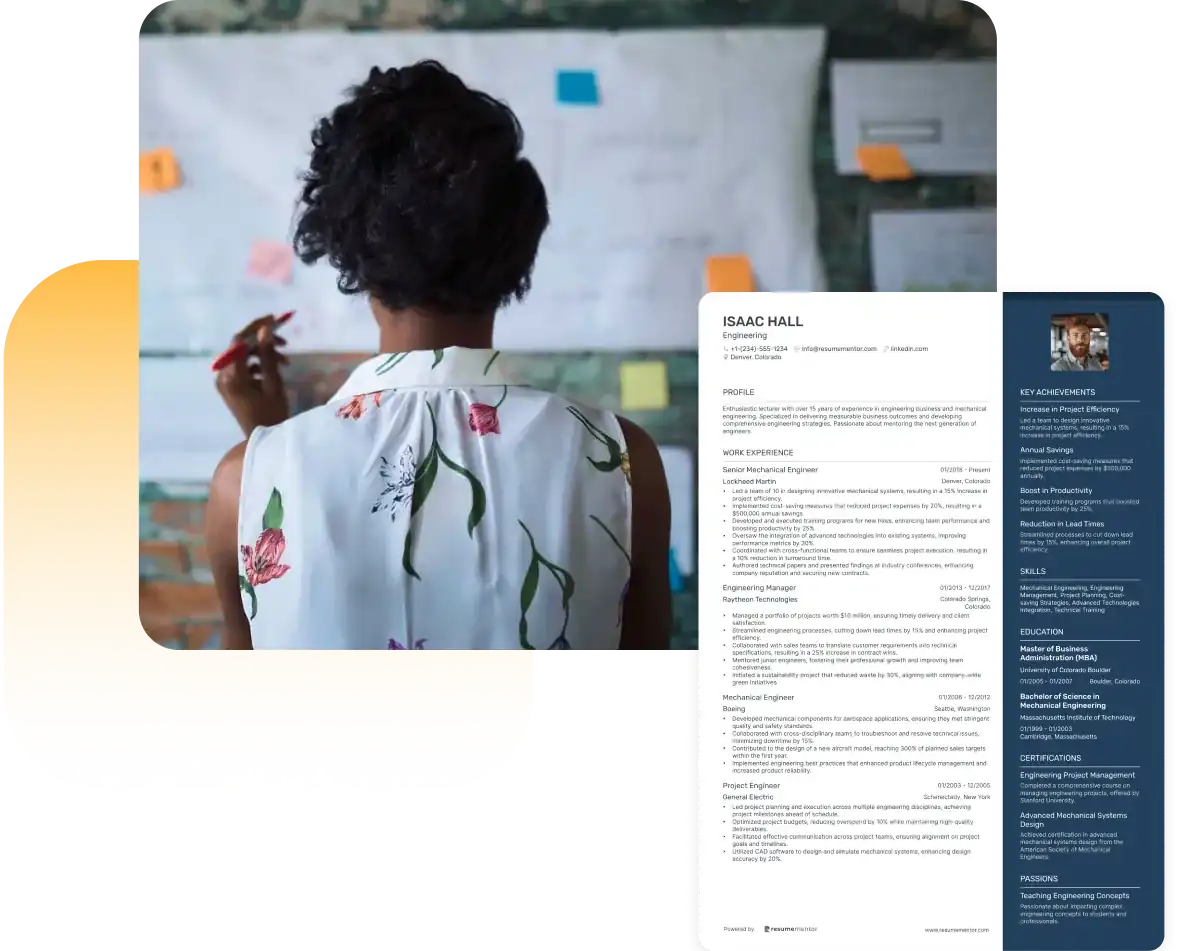
Continue Reading
Check more recommended readings to get the job of your dreams.
Resume
Resources
Tools
© 2025. All rights reserved.
Made with love by people who care.

